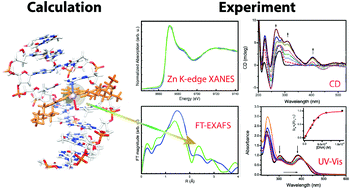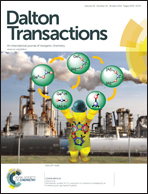Nickel(ii), copper(ii) and zinc(ii) metallo-intercalators: structural details of the DNA-binding by a combined experimental and computational investigation†
Abstract
We present a thorough characterization of the interaction of novel nickel(II) (1), copper(II) (2) and zinc(II) (3) Schiff base complexes with native calf thymus DNA (ct-DNA), in buffered aqueous solution at pH 7.5. UV-vis absorption, circular dichroism (CD) and viscometry titrations provided clear evidence of the intercalative mechanism of the three square-planar metal complexes, allowing us to determine the intrinsic DNA-binding constants (Kb), equal to 1.3 × 107, 2.9 × 106, and 6.2 × 105 M−1 for 1, 2 and 3, respectively. Preferential affinity, of one order of magnitude, toward AT compared to GC base pair sequences was detected by UV-vis absorption titrations of 1 with [poly(dG-dC)]2 and [poly(dA-dT)]2. Structural details of the intercalation site of the three metal complexes within [dodeca(dA-dT)]2 were obtained by molecular dynamics (MD) simulations followed by density functional theory/molecular mechanics (DFT/MM) calculations. The calculations revealed that three major intermolecular interactions contribute to the strong affinity between DNA and the three metal complexes: (1) the electrostatic attraction between the two positively charged triethylammoniummethyl groups of the metal complexes and the negatively charged phosphate groups of the DNA backbone; (2) the intercalation of the naphthalene moiety within the four nitrogen bases of the intercalation site; (3) the metal coordination by exocyclic donor atoms of the bases, specifically the carbonyl oxygen and amine nitrogen atoms. Remarkably, the Gibbs formation free energy calculated for the intercalation complexes of 1, 2 and 3 with [dodeca(dA-dT)]2 in the implicit water solution is in agreement with the experimental Gibbs free energy values obtained from the DNA-binding constants as ΔG° = −RT ln(Kb). In particular, the DNA-binding affinity trend, 1 > 2 > 3, is reproduced. Finally, the first shell coordination distances calculated for the intercalation complex 3/[dodeca(dA-dT)]2 are in excellent agreement with the experimental distances extracted from the extended X-ray absorption fine structure (EXAFS) spectrum of the corresponding 3/ct-DNA solutions. The latter results provided the first evidence of metal ion coordination by native DNA in aqueous solution.


 Please wait while we load your content...
Please wait while we load your content...